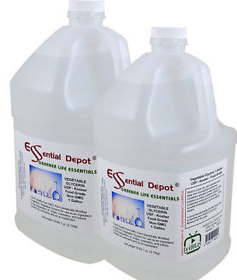What is Vegetable Glycerin?
Vegetable glycerin is a thick liquid similar to the thickness of maple syrup; it is produced using plant oils. Most often the plant oils used to produce vegetable glycerin are Palm, Coconut and Soy.
You will often hear soap makers tell you that their soap contains the natural glycerin that is because in cold process soap making the soap retains the glycerin, where as many large soap manufacturers use glycerin as a by product adding it to their more expensive lotions and creams.
Glycerin is made by heating the vegetable oils and mixing that with a sodium hydroxide water mix (which produces a soap) The solution is mixed and cooled at which time the glycerin will sink to the bottom. The glycerin that settles to the bottom would be the by-product. The rest would be made into soap.
Vegetable glycerin can also be made by heating your oils to a high temperature under pressure with water; the water absorbs the glycerin from the oils. It is then distilled to get the pure product.
Glycerin is well known for it’s humectant properties which helps prevent loss of moisture in your skin. Glycerin will draw moisture from the lower layers of your skin to the surface protecting it from becoming dehydrated.
What is vegetable glycerin used for?
Vegetable glycerin is used in cosmetics, shampoos, soaps, pharmaceuticals and other  household items.
household items.
Added to shampoos glycerin will help to protect your hair when using styling tools such as hair dryers and curling irons.
It is used in soap, creams and lotions for it’s moisturizing abilities.
The pharmaceutical industry uses glycerin as a sweetener in cough syrups, lozenges, and laxatives and in eyewash solutions.
Some skin benefits from glycerin
As a cleanser- 2 tbsp. glycerin and one tsp. citric acid (I got this recipe from a friend who uses it as a facial scrub and loves it) I have not used this, as I am allergic to citric acid.
As a toner – rosewater and glycerin1/2 cup glycerin to 3 cups rose water – put in a spray bottle and use, as you’d like.
Moisturizer – It is often added to creams and lotions because of it’s ability to help the skin retain moisture.
© 2016, Tes. All rights reserved.